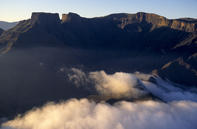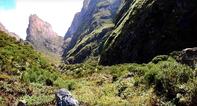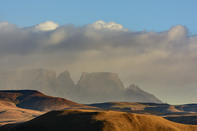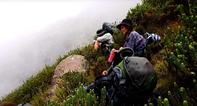Historical Climbs
Despite its prominence, both the small bump of Champagne Castle behind the cliff line of the Drakensberg Enscarpment and Monk's Cowl in the dark gap between the two, are higher:

Champagne Castle, at 3 248 m, is often held to be the second highest peak of the Drakensberg, but by modern reckoning it is only number three (after Mafadi and Injisuthi Dome). The route up to Champagne Castle is, in climbing terms, a doddle, but hikers know it as the exhausting Gray's Pass which was first done in 1861.
It was done officially as a route by the formidable Stocker Brothers only in 1888. In 1888 the Stockers (members of the British Alpine Club, one a priest) attempted Cathkin Peak by the south gully and got to within 150 metres of the top before being turned back by a blank face. Only in 1912 was the wall scaled by George Amphlett, Father Kelly of Bloemfontein and four others.
Today much harder routes have been climbed, including the one on which George Thompson (a young bricklayer from New Zealand) fell, broke an ankle, then finished the climb. The story of the climbing of the 'little chief’, Nkosana, is much more breathtaking.
Little Chief

The 'Little Chief" is the Monk's Cowl, and it hides between Cathkin and Champagne, a dark brooding presence like a giant dragon's fang. The ‘standard route' was established in 1942 by Hans Wongschowski and party, who spoke of its 'cold, fascinating beauty'. Of this occasion Reg Pearse writes in Barrier of Spears: 'As they approached Champagne Castle Hotel in their car, a devastating storm broke over them.
Trees were uprooted, the front of the car was lifted bodily into the air by a tremendous gust of wind. A nearby house collapsed like a pack of cards. It was almost as if the guardian spirits of uKhahlamba were making a last desperate effort to protect the inviolability of the virgin peak.' Oom Hendrik Maartens, who owned the hotel in those days, flatly refused to believe such a peak could - ever - be climbed. He secretly sent a nephew up Champagne Castle to see if the cairn the party claimed to have built was there - and it was.
Cathkin Peak

The 1938 Cathkin Peak attempt by Dick Barry and Colin Gerbhardt is the one of legend. Barry was called 'the tiger' by his generation. In 1938 he was only 22 when he and Gerbhardt set off from Cathkin Park Hotel. They started the climb up the north gully in intermittent rain, mist and shine, forging a route up the north-west face: D-grade grass and rubble ledges gave way to E-grade faces.
Finally E became F, and as Gerbhardt was easing up to Barry on a narrow belay stance two-thirds of the way up the peak, right next to the crux traverse pitch, his handhold pulled out and down he went. When their rope pulled taut Barry too was yanked off. They plummeted and tumbled about a hundred metres and, although otherwise uninjured, Barry lay unconscious for two hours. Now they were stuck on an inaccessible ledge in shorts and socks (for that's how they climbed), their tackies safe with their food and water bottles, rain gear, extra rope, pitons and a camera in a rucksack up on their last belay ledge.
The short story is that a probably concussed Barry, while looking for an easy way down to the right (Gerbhardt said he knew there wasn't one), fell to his death. In 1952 Des Watkins and Gillian Bettle found Barry's rucksack at the point from which he fell. Then Watkins fell and although Bettle held the rope, Watkins suffered several fractured ribs and they had to abandon the climb.
Barry's Route yielded only in 1962, then leader Malcolm Moor taking three and a half hours to do the four-metre crux section. It is seldom repeated, other than by parties going off route by following bits of abseil rope left by other parties that have gone astray.
Monk's Cowl

There have been more climbing accidents on Monk's Cowl than probably any other peak in the country. Even nowadays in the MCSA journal you can read the occasional harrowing account of someone who has tried, and mostly failed. One mountaineer, Clive Ward, took a tumble.
He was trying a new aided line on Barry's Route, having fixed his etriers (a short rope-ladder) in a crack where an old bit of frayed rope hung from a piton, when the whole section of wall fell away. He went flying, holding on to a double-bed size flake which, he said later, he thought would become his tombstone.
Near Cathkin Park, where the summit of the Cowl is just visible, lies a block of sandstone with a brass plaque with Dick Barry's name on it and the words 'who gave his life to the mountains he loved'. And I must say, when my time is up I hope I will be in the Drakensberg, or at least have my ashes scattered there.
At the base of Gray's Pass is a spot marked on old maps as Keith Bush Hut. The hut is now gone (demolished in line with the old wilderness guidelines), but it marks a spot close to where Keith Bush fell when his abseil sling broke, he and his two companions had just completed the first successful ascent of the north face.
By David Bristow